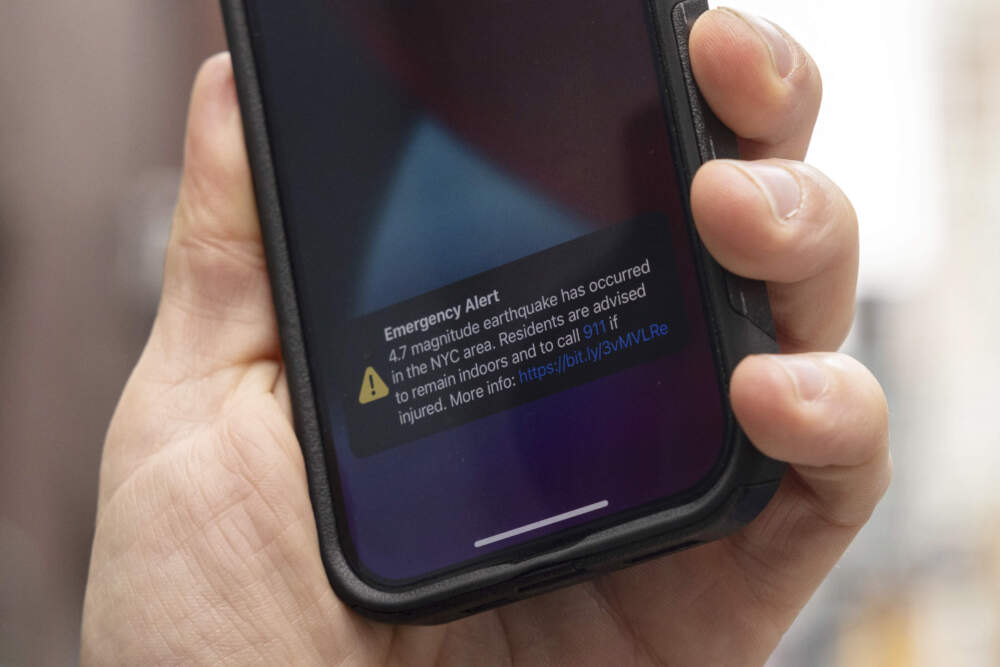Advertisement
New Jersey earthquake shakes Eastern Seaboard, rumbles felt in Mass.

An earthquake shook the densely populated New York City metropolitan area Friday morning, the U.S. Geological Survey said, with residents across the Northeast reporting rumbling in a region where people are unaccustomed to feeling the ground move.
The agency reported a quake at 10:23 a.m. with a preliminary magnitude of 4.8, centered near Lebanon, New Jersey, or about 45 miles west of New York City and 50 miles north of Philadelphia. U.S.G.S. figures indicated that the quake might have been felt by more than 42 million people.
New York City’s emergency notification system said in a social media post more than 30 minutes after the quake that it had no reports of damage or injuries in the city. The Fire Department of New York said on social media about an hour after the quake that it was “responding to calls and evaluating structural stability” but that there are “no major incidents at this time.”

Amtrak said it was inspecting its tracks and had speed restrictions in place throughout the busy Northeast Corridor. New Jersey Transit posted on X that its train system was subject to delays caused by bridge inspections. The Philadelphia area's PATCO rail line suspended service out of what it said was "an abundance of caution.”
In midtown Manhattan, the usual cacophony of traffic grew louder as motorists blared their horns on momentarily shuddering streets. Some Brooklyn residents heard a booming sound and their building shaking. In an apartment house in Manhattan’s East Village, a resident from more earthquake-prone California calmed nervous neighbors.
At a coffee shop in lower Manhattan, customers buzzed over the unexpected earthquake, which rattled dishware and shook the concrete counter. “I noticed the door trembling on its frame,” said India Hays, a barista. “I thought surely there couldn’t be an earthquake here.”
People from Baltimore to Philadelphia and Boston reported the shaking. Boston College professor John Ebel, a research scientist with Weston Observatory, called this event a once-in every-20-year earthquake. He said it was a reminder that earthquakes do happen on the East Coast.
"At some point in the future — maybe not for a hundred years, maybe tomorrow — there could be a strong damaging one, maybe 6 or 6.5," Ebel said.
Tremors lasting for several seconds were felt over 200 miles away near the Massachusetts-New Hampshire border. People across New England posted reports of feeling tremors on the geological survey website.
The Massachusetts Emergency Management Agency posted on X, formerly known as Twitter, that they received "multiple reports of shaking" in the state and were reaching out to communities for any reports of damage. They also pointed followers to earthquake safety tips.
New York Gov. Kathy Hochul posted on X that the quake was felt throughout the state. “My team is assessing impacts and any damage that may have occurred, and we will update the public throughout the day,” Hochul said.
The White House said in a statement that President Joe Biden had been briefed on the earthquake and was “in touch with federal, state, and local officials as we learn more.”
Earthquakes are less common on the eastern than western edges of the U.S. because the East Coast does not lie on a boundary of tectonic plates. The biggest Eastern quakes usually occur along the mid-Atlantic Ridge, which extends through Iceland and the Atlantic Ocean.
Quakes on the East Coast can still pack a punch, as its rocks are better than their western counterparts at spreading earthquake energy across far distances.
“If we had the same magnitude quake in California, it probably wouldn’t be felt nearly as far away,” said USGS geophysicist Paul Caruso.
A 4.8-magnitude quake isn't large enough to cause damage, except for some minor effects near the epicenter, the agency posted on X.
Earthquakes with magnitudes near or above 5 struck near New York City in 1737, 1783 and 1884, the USGS said. And Friday's stirred memories of the Aug. 23, 2011, earthquake that jolted tens of millions of people from Georgia to Canada. With an epicenter in Virginia, it left cracks in the Washington Monument and rattled New Yorkers ahead of the 10th anniversary of the Sept. 11 terror attacks.
Registering magnitude 5.8, it was the strongest earthquake to hit the East Coast since World War II.
Two minor magnitude earthquakes shook Massachusetts in November 2020. A 3.6 magnitude quake struck off the coast of New Bedford early that month, followed by a 2.0 magnitude earthquake in Dartmouth in late November.
With reporting from the WBUR Newsroom.
This article was originally published on April 05, 2024.